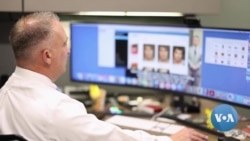ເທັກໂນໂລຈີໃນການຈື່ຈຳໃບໜ້າ ສາມາດປ່ຽນແປງໃບໜ້າຂອງສົງຄາມໄດ້. Julie Taboh ນັກຂ່າວວີໂອເອ ມີລາຍງານເລື້ອງນີ້ ຊຶ່ງບົວສະຫວັນ ຈະນຳມາສະເໜີທ່ານ ໃນອັນດັບຕໍ່ໄປ.
ເຖິງແມ່ນວ່າ ມັນຈະເປັນເລື້ອງທີ່ໂຕ້ແຍ້ງກັນຢູ່ກໍ່ຕາມ ແຕ່ຕຳຫຼວດສະຫະລັດກໍໄດ້ກາງຕໍ່ອາໄສໂປຣແກຣມ ຫລືຊອຟແວໃນການຈື່ຈຳໃບໜ້າຄົນຫຼາຍຂຶ້ນ ເພື່ອລະບຸຕົວຜູ້ຕ້ອງສົງໄສ ແລະຜູ້ໄດ້ຮັບເຄາະຮ້າຍ. ໃນປັດຈຸບັນເທັກໂນໂລຈີນີ້ກໍາລັງຖືກນໍາໃຊ້ໃນສົງຄາມ ເພື່ອລະບຸຕົວຜູ້ຕາຍ, ສັດຕູ, ແລະຜູ້ຕ້ອງສົງໄສ ໃນການກໍ່ອາຊະຍາກໍາສົງຄາມທີ່ເປັນໄປໄດ້.
ທ່ານລີໂອນິດ ທີມເຊັນໂກ (Leonid Tymchenko) ເປັນຫົວຫນ້າກົມຂໍ້ມູນ ຂ່າວສານ ແລະການສະຫນັບສະຫນູນການວິເຄາະຂອງຫ້ອງການຕໍາຫຼວດແຫ່ງ ຊາດຂອງຢູເຄຣນ. ທ່ານໄດ້ໂອ້ລົມກັບວີໂອເອ (VOA) ຜ່ານທາງ Skype ວ່າ:
“ການຈຳໃບໜ້າໄດ້; ມັນເປັນນຶ່ງໃນເຄື່ອງມືທີ່ເປັນປະໂຫຍດຫຼາຍແທ້ໆ ທີ່ພວກ ເຮົາໃຊ້ໃນປັດຈຸບັນນີ້, ແລະມັນເຮັດວຽກໄດ້ຢ່າງສົມບູນແບບເລີຍ. ຢູ່ພາຍໃນ ຫ້ອງການຕໍາຫຼວດແຫ່ງຊາດຂອງຢູເຄຣນ, ພວກເຮົາມີຫຼາຍກວ່າຫ້າກົມ ທີ່ນໍາ ໃຊ້ມັນ."
ບໍລິສັດເຄລຍວີວ ເອໄອ (Clearview AI), ບໍລິສັດຊອຟແວ ຈຳໃບໜ້າ ຄົນຂອງສະຫະລັດ ໄດ້ໃຫ້ເຈົ້າໜ້າທີ່ຢູເຄຣນນຳໃຊ້ຖານຂໍ້ມູນຂອງຕົນທີ່ບັນຈຸໃບໜ້າຂອງຫຼາຍຕື້ຄົນ ເພື່ອກວດກາເບິ່ງລັກສະນະທີ່ບົ່ງບອກຕົວ ຂອງ ທະຫານຣັດເຊຍ. ບໍລິສັດເກັບກໍາຮູບພາບຈາກເວັບໄຊທ໌ເຊັ່ນເຟສບຸກ ແລະ ເວັບໄຊທ໌ສາທາລະນະອື່ນໆ, ລວມທັງຈາກເວັບໄຊທ໌ສື່ສັງຄົມຂອງຣັດເຊຍ ເຊັ່ນ ວຄອນຕັກເຕ (VKontakte), ຫຼື VK.
ທ່ານຫວນ ທົນ ທັດ (Hoan Ton-That) ເປັນຜູ້ຮ່ວມກໍ່ຕັ້ງ ແລະ CEO ຂອງບໍລິສັດ Clearview AI. ທ່ານໄດ້ໂອ້ລົມກັບ VOA ຜ່ານທາງ Skype ວ່າ:
"ພວກເຂົາມີຮູບຂອງທະຫານທີ່ເສຍຊີວິດສອງຄົນ, ຜູ້ນຶ່ງໃນນັ້ນມີບັດປະຈໍາຕົວ ຕິດຢູ່ນຳ, ແລະອີກຄົນນຶ່ງບໍ່ມີ, ດັ່ງນັ້ນພຽງແຕ່ຈາກຮູບຂອງໃບຫນ້າເທົ່ານັ້ນ ພວກເຂົາເຈົ້າກໍສາມາດເອົາມັນໄປແລ່ນຜ່ານລະບົບໄດ້ແລ້ວ. ແລະເຂົາເຈົ້າສາມາດລະບຸພາບໃນໂປຣໄຟລ໌ໃນສື່ສັງຄົມອອນລາຍຂອງຜູ້ທີ່ເສຍຊີວິດ ໃນປັດຈຸບັນນັ້ນໄດ້."
ທ່ານທົນ ທັດ (Ton-That) ເວົ້າວ່າ ຖ້າຫາກຄົນຮູ້ຈັກຕົວຕົນຂອງເຂົາເຈົ້າ ໃນທີ່ສຸດ ກໍຈະກໍານົດໄດ້ຈາກຮູບທີ່ຖ່າຍໂດຍໂທລະສັບ, ເທັກໂນໂລຈີ ທີ່ວ່ານີ້ ອາດຈະເຮັດຫນ້າທີ່ ໃນການຂັດຂວາງການກໍ່ອາຊະຍາກໍາສົງຄາມໄດ້. ແຕ່ວ່າ ບໍລິສັດ Clearview ແມ່ນເປັນບັນຫາໂຕ້ແຍ້ງຢູ່ໃນສະຫະລັດ ຍ້ອນວິທີທີ່ມັນໄດ້ເອົາຮູບມາ ແລະວິທີການນໍາໃຊ້ຊອຟແວຂອງມັນ.
ນັກຄົ້ນຄວ້າດ້ານເທັກໂນໂລຈີ, ທ່ານນາງສເຕັຟຟານີ ແຮ (Stephanie Hare) ແມ່ນຜູ້ຂຽນປຶ້ມເຫລັ້ມໃຫມ່ ທີ່ຊື່ວ່າ "ເທັກໂນໂລຈີບໍ່ແມ່ນເປັນກາງ." ທ່ານນາງໄດ້ໂອ້ລົມກັບ VOA ຜ່ານທາງ Skype ວ່າ:
"ຮູບແບບທຸລະກິດຂອງ Clearview AI ແມ່ນການເອົາຂໍ້ມູນກ່ຽວກັບໃບໜ້າ ຂອງເຈົ້າ ທີ່ເຈົ້າເອົາໃສ່ ບາງເທື່ອກໍແມ່ນເອົາໃສ່ ຢູ່ໃນອາລະບໍາຮູບທາງ ອອນລາຍ, ຫຼືໃນບັນຊີສື່ສັງຄົມຂອງເຈົ້າ ເພື່ອຈຸດປະສົງທີ່ແຕກຕ່າງກັນຫຼາຍ, ແລະປ່ຽນມັນໃຫ້ກາຍເປັນອາວຸດທີ່ກຳລັງຖືກໃຊ້ຕອນນີ້ຢູ່ໃນເວທີສົງຄາມ."
ພວກຕຳໜິບໍລິສັດ Clearview ສະແຫວງຫາການສະຫນັບສະຫນູນ ໃຫ້ມີກົດລະບຽບທີ່ເຂັ້ມງວດຂຶ້ນສຳລັບເທັກໂນໂລຈີ. ແຕ່ສໍາລັບຜູ້ທີ່ຕໍ່ສູ້ກັບຄວາມໂຫດ ຮ້າຍໃນສົງຄາມ, ຊອຟແວໃນການຈື່ຈຳໃບຫນ້າໄດ້ ແມ່ນເຄື່ອງມືທີ່ໃຫ້ຮັກສາໄວ້.
ອ່ານຂ່າວນີ້ເພີ້ມເປັນພາສາອັງກິດຢູ່ລຸ່ມນີ້:
Facial recognition technology could be changing the face of war. VOA’s Julie Taboh reports.
Though controversial, U.S. police are increasingly relying on facial recognition software to identify suspects and victims. Now the technology is being used in war, to identify the dead, potential enemies, and suspects of war crimes.
Leonid Tymchenko ((Lee-oh-need teem-Chenko)) is head of the department of information and analytical support of the National Police of Ukraine. He spoke with VOA via Skype.
“Facial recognition; it's one of the very, very useful tools which we use right now, and it works perfect. Inside the National Police of Ukraine, we have more than five departments who use it.”
Clearview AI, a U.S. facial recognition software firm, has given Ukrainian officials use of its database containing billions of faces to check the identities of Russian soldiers. The company collects images from sites like Facebook and other public websites, including from Russian social media sites such as VKontakte, or VK.
Hoan Ton-That ((Juan Ton-Tat)) is co-founder and CEO of Clearview AI. He spoke with VOA via Skype:
"They had photos of two deceased soldiers; one of them had identification on them, and the other one did not. And so just from the photo of the face, they were able to run it through the system. And they've been able to identify the online social media profile of the person who's now deceased."
Ton-That says that if people know their identity will eventually be determined from a photo snapped by a phone, the technology may act as a deterrent to war crimes. But Clearview is controversial in the U.S. because of how it obtains photos and how its software has been used.
Technology researcher Stephanie Hare is the author of a new book, "Technology is not Neutral." She spoke with VOA via Skype:
"That Clearview AI's business model is taking your face data that you've put up, maybe on an online photo album, or on your social media accounts, for a very different purpose, and turned it into a weapon that's now being used in a theater of war."
Critics of Clearview advocate for stronger regulations of the technology. But for those grappling with wartime atrocities, facial recognition software is a tool to keep.





